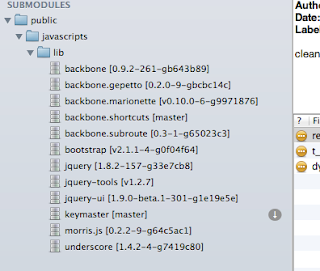Chrome autosave extension was huge bump in the quality of the web-application development. It allowed editing code in the chrome developer tools and then, with use of small node.js application syncing changes back to the source files.
Tincr brings it to the next level by providing synchronisation in the opposite direction. It is capable of reloading assets that you have touched without refreshing complete browser session!
Due to my two-server configuration in which my assets (javascript & css) are loaded out of the node-static server and only RoR generated json comes from ruby, tincr required non-trivial configuration separating assets from generated contents.
For testing purposes I have made a pet project, that loads assets from localhost:4444
19.11.12
jQuery and HTTP acceptable content-type request header
As a consequence of the fact that SAW turns into the single-page application, the user authentication process required an adoption to use XHR requests. In fact the default mode of operation for devise is, whenever user is not authenticated, to use HTTP 302 status to forward web browser to the authentication page. For a RESTful client application this is not a desired behavior as it confuses backbone in where the particular resource can be found. In fact the proper behavior is to return HTTP 401 status, so that it can be caught and client can decide how to proceed.
Trying to implement this I found that my back-end (devise & RoR) is supporting multiple content-types for the request, and it would be most happy to deliver HTML (over JSON). To my surprise specifying JSON as desired content-type in jQuery still resulted in getting 302. Careful investigation resulted in finding that no matter what is the desired content-type, jQuery always attaches */* to the list of accepted types (through allTypes variable). I can imagine that */* should serve as a fall-back for the situation when the desired content-type is not available, but in that case */* should have a different weight (q parameter). Specifying them in the single header line makes the server treat desired content-type and fall-back as equal.
In fact removing "allTypes" has fixed the problem. I'm now getting 401 which can be caught globally, save the requested URL in localStorage, and perform the right redirection:
jQuery(function() {
jQuery("body").ajaxError(function(event, request, settings){
if( request.status === 401 ) {
localStorage.setItem('SAWurl',window.location.href);
alert( "You are not logged in!" );
window.location.href="/users/sign_in";
}
});
});
I would be eager to hear your opinion whenever this is a bug or a feature of jQuery.
Trying to implement this I found that my back-end (devise & RoR) is supporting multiple content-types for the request, and it would be most happy to deliver HTML (over JSON). To my surprise specifying JSON as desired content-type in jQuery still resulted in getting 302. Careful investigation resulted in finding that no matter what is the desired content-type, jQuery always attaches */* to the list of accepted types (through allTypes variable). I can imagine that */* should serve as a fall-back for the situation when the desired content-type is not available, but in that case */* should have a different weight (q parameter). Specifying them in the single header line makes the server treat desired content-type and fall-back as equal.
In fact removing "allTypes" has fixed the problem. I'm now getting 401 which can be caught globally, save the requested URL in localStorage, and perform the right redirection:
jQuery(function() {
jQuery("body").ajaxError(function(event, request, settings){
if( request.status === 401 ) {
localStorage.setItem('SAWurl',window.location.href);
alert( "You are not logged in!" );
window.location.href="/users/sign_in";
}
});
});
I would be eager to hear your opinion whenever this is a bug or a feature of jQuery.
GIT submodules overkill
Git has this faboulous feature of (sub-)modularization of the repositories. Over the course of over two years of development SAW grew up in terms of sub-modules. Sub-modularization has is beneficial mainly because it gives an ease of pulling updates without violating source code of the system under implementation.
The practice of managing sub-modules that I found particularly successful is to always fork official github repositories and refer to them as sub-modules.
This technique allows clear separation from the official repository and sometimes necessary customization.
The gotcha of the sub-modularization is that often libraries come in the half-backed condition that requires some degree of building them (with make, grunt, or ant). For my purposes I invested in one, central "deploy" bash script that:
The practice of managing sub-modules that I found particularly successful is to always fork official github repositories and refer to them as sub-modules.
This technique allows clear separation from the official repository and sometimes necessary customization.
The gotcha of the sub-modularization is that often libraries come in the half-backed condition that requires some degree of building them (with make, grunt, or ant). For my purposes I invested in one, central "deploy" bash script that:
- performs pull from central repository,
- performs submodule initialization and updating
- builds libraries (in particular jquery and jquery-ui)
- compiles JavaScript assets (with jammit)
- instructs RoR application server (passenger) to reload application sources
Full source of the script can be found here. The screen-shoot was made out of fabulous OSX git (and not only GIT) gui named SourceTree.
Subscribe to:
Posts (Atom)
